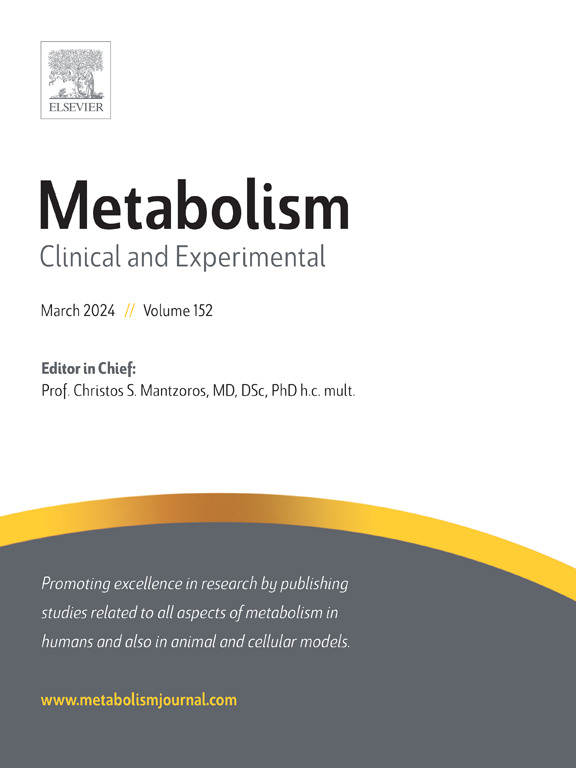GDF-15 提高了脂肪肝无创检测对心肾代谢疾病和恶性肿瘤发病率和死亡率的预测能力。
IF 11.9
1区 医学
Q1 ENDOCRINOLOGY & METABOLISM
引用次数: 0
摘要
背景和目的:无创工具(NIT)目前用于对肝脏脂肪变性或肝纤维化的风险进行分层。这些工具在预测长期心肾代谢疾病、恶性肿瘤以及特定病因和全因死亡率方面的性能和蛋白质组学改进方面尚有欠缺。因此,需要研究已建立的 NITs 在识别心肾代谢疾病、恶性肿瘤、特定病因和全因死亡率方面的性能,并利用新型蛋白质组 NITs(包括生长分化因子 15 (GDF-15))提高其性能,从而实现多用途利用。方法:502,359 名英国生物库参与者在基线时未出现研究结果,中位随访期为 14 年,他们被分为三类:a)普通人群;b)潜在的代谢功能障碍相关性脂肪性肝病(MASLD)人群;c)2 型糖尿病患者。研究的NIT包括天冬氨酸氨基转移酶与血小板比率指数(APRI)、纤维化4指数(FIB-4)、脂肪肝指数(FLI)、肝脏脂肪变性指数(HSI)、脂质累积产物(LAP)和代谢功能障碍相关纤维化(MAF-5)评分:与传统的NIT相比,在现有的NIT中添加GDF-15几乎在所有情况下都能显著提高预后效果,C指数大幅提高,在0.601到0.808之间,C指数总体提高了0.2以上。总体而言,与传统的 NIT 相比,GDF-15 增强型 NIT 所需的筛查人数要少七倍以上,才能发现更多的不良后果事件。根据 NIT 的连续值百分位数,所有结果的累积发生率在 GDF-15 增强型 NIT 的上五分位数呈指数增长:本文开发的 GDF-15 增强指数显示出更高的筛查效果和显著改善的预后能力,并通过一个易于使用的网络计算工具 (https://clinicalpredictor.shinyapps.io/multimorbidity-mortality-risk/) 将其应用到实践中。本文章由计算机程序翻译,如有差异,请以英文原文为准。

GDF-15 improves the predictive capacity of steatotic liver disease non-invasive tests for incident morbidity and mortality risk for cardio-renal-metabolic diseases and malignancies
Background & aims
Noninvasive tools (NITs) are currently used to stratify the risk of having or developing hepatic steatosis or fibrosis. Their performance and a proteomic-enabled improvement in forecasting long-term cardio-renal-metabolic morbidity, malignancies, as well as cause-specific and all-cause mortality, are lacking. Therefore, the performance of established NITs needs to be investigated in identifying cardio-renal-metabolic morbidity, malignancies, cause-specific and overall mortality and improve their performance with novel, proteomic-enabled NITs, including growth differentiation factor 15 (GDF-15), allowing multipurpose utilization.
Methods
502,359 UK Biobank participants free of the study outcomes at baseline with a 14-year median follow-up were grouped into three categories: a) general population, b) potentially metabolic dysfunction-associated steatotic liver disease (MASLD) population, c) individuals with type 2 diabetes mellitus. The investigated NITs include Aspartate aminotransferase to Platelet Ratio Index (APRI), Fibrosis 4 Index (FIB-4), Fatty Liver Index (FLI), Hepatic Steatosis Index (HSI), Lipid Accumulation Product (LAP), and metabolic dysfunction–associated fibrosis (MAF-5) score.
Results
Adding GDF-15 to the existing NITs led to significantly increased prognostic performance compared to the traditional NITs in almost all instances, reaching substantially high C-indices, ranging between 0.601 and 0.808, with an overall >0.2 improvement in C-index. Overall, with the GDF-15 enhanced NITs, up to more than seven times fewer individuals need to be screened to identify more incident cases of adverse outcomes compared to the traditional NITs. The cumulative incidence of all outcomes, based on the continuous value percentiles of NITs, is increasing exponentially in the upper quintile of the GDF-15 enhanced NITs.
Conclusions
The herein-developed GDF-15 enhanced indices demonstrate higher screening effectiveness and significantly improved prognostic abilities, which are reduced to practice through an easy-to-use web-based calculator tool (https://clinicalpredictor.shinyapps.io/multimorbidity-mortality-risk/).
求助全文
通过发布文献求助,成功后即可免费获取论文全文。
去求助
来源期刊

Metabolism: clinical and experimental
医学-内分泌学与代谢
CiteScore
18.90
自引率
3.10%
发文量
310
审稿时长
16 days
期刊介绍:
Metabolism upholds research excellence by disseminating high-quality original research, reviews, editorials, and commentaries covering all facets of human metabolism.
Consideration for publication in Metabolism extends to studies in humans, animal, and cellular models, with a particular emphasis on work demonstrating strong translational potential.
The journal addresses a range of topics, including:
- Energy Expenditure and Obesity
- Metabolic Syndrome, Prediabetes, and Diabetes
- Nutrition, Exercise, and the Environment
- Genetics and Genomics, Proteomics, and Metabolomics
- Carbohydrate, Lipid, and Protein Metabolism
- Endocrinology and Hypertension
- Mineral and Bone Metabolism
- Cardiovascular Diseases and Malignancies
- Inflammation in metabolism and immunometabolism
 求助内容:
求助内容: 应助结果提醒方式:
应助结果提醒方式:


